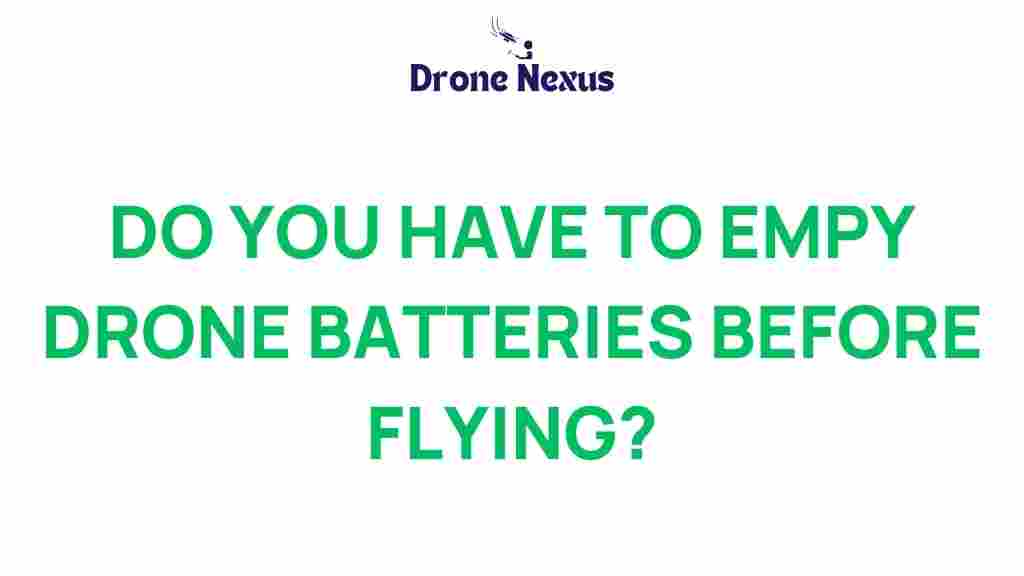The Essential Guide: Do You Really Need to Empty Drone Batteries Before Flight?
As the popularity of drones continues to soar, questions about their maintenance and battery management have become increasingly relevant. One common query among drone enthusiasts and pilots is whether they really need to empty their drone batteries before flight. Understanding the intricacies of drone batteries is essential for ensuring not only optimal performance but also longevity. In this guide, we will explore the importance of drone batteries, the impact of battery management on flight performance, and the best practices to follow.
Understanding Drone Batteries
Before diving into whether you need to empty drone batteries, it’s important to understand what they are and how they work. Most drones utilize lithium polymer (LiPo) batteries due to their lightweight and high-energy density. These batteries come with specific characteristics that affect their performance, including:
- Voltage Rating: Each cell in a LiPo battery has a nominal voltage of 3.7V. The total voltage is determined by the number of cells in series.
- Capacity: Measured in milliamp hours (mAh), capacity indicates how much energy the battery can store.
- Discharge Rate: This rating (often marked as ‘C’) indicates how quickly a battery can safely discharge its stored energy.
Do You Need to Empty Drone Batteries?
The straightforward answer is: no, you do not need to empty drone batteries before every flight. However, there are nuances to consider:
- Storage Practices: If you plan to store your drone batteries for an extended period, it’s essential to discharge them to a storage voltage of around 3.7V to 3.85V per cell. This helps prolong battery life.
- Flight Preparation: Before a flight, it’s crucial to charge your batteries fully. Starting with a full charge maximizes flight time and performance.
- Battery Health: Regularly discharging your drone batteries completely can lead to decreased lifespan and performance. A partial discharge is often advisable.
Best Practices for Managing Drone Batteries
To maintain optimal health and performance of your drone batteries, adhere to the following best practices:
- Regular Charging: Always charge your batteries before flights. Avoid flying with partially charged batteries unless necessary.
- Avoid Over-Discharging: It’s crucial not to let the battery voltage drop below the manufacturer’s recommended level (usually around 3.0V per cell).
- Use a Quality Charger: Invest in a reliable charger designed for LiPo batteries. This ensures safe charging and reduces the risk of battery damage.
- Store Properly: Store your batteries in a cool, dry place. Using fireproof bags for storage can also enhance safety.
Step-by-Step Process for Preparing Drone Batteries for Flight
Now that you understand the importance of drone batteries and their management, here’s a step-by-step guide to prepare your batteries for flight:
- Inspect the Battery: Check for any physical damage, swelling, or signs of wear. Do not use damaged batteries.
- Charge the Battery: Use a quality LiPo charger to fully charge your batteries before the flight.
- Check the Voltage: Use a voltage checker to ensure each cell is balanced and within the safe range.
- Install the Battery: Securely connect the battery to the drone, ensuring proper polarity and connection.
- Test the Drone: Before taking off, run pre-flight checks to ensure everything is functioning correctly.
Troubleshooting Common Drone Battery Issues
Even with the best practices in place, you may encounter issues with your drone batteries. Here are some common problems and their solutions:
- Battery Not Charging: Check the charger and connections. If the charger is malfunctioning, try a different charger.
- Short Flight Times: This may indicate a battery that is nearing the end of its life. Consider replacing it.
- Swollen Battery: A swollen battery is dangerous. Discontinue use immediately and dispose of it according to local regulations.
- Inconsistent Voltage Readings: This could indicate a faulty cell. Test each cell individually and replace the battery if necessary.
When to Replace Drone Batteries
Knowing when to replace your drone batteries is crucial for safety and performance. Here are some signs that indicate it’s time for a new battery:
- Decreased Capacity: If your flight time has significantly decreased, it may be time to consider a replacement.
- Physical Damage: Any signs of swelling, punctures, or other damage mean that the battery should not be used.
- Age: LiPo batteries typically have a lifespan of 2-3 years. After this period, performance may decline.
Conclusion
In conclusion, you do not need to empty drone batteries before every flight, but understanding how to manage them properly can greatly enhance their performance and longevity. Always charge your batteries fully before a flight, avoid over-discharging, and store them correctly for optimal health. By following the best practices outlined in this guide, you can ensure that your drone batteries remain in excellent condition, allowing you to enjoy uninterrupted flying experiences.
For more detailed information about drone maintenance and technology, check out this comprehensive resource. If you’re looking for quality drone batteries and accessories, visit this site for reliable options.
This article is in the category Safety and created by DroneNexus Team
